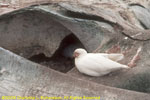

Petrels are similar in shape to albatrosses, but have only one nasal passage on top of their beaks, and are referred to as "tubenoses". Like albatrosses, they spend almost their entire lives at sea.
Giant petrel (Macronectes sp.)


Giant petrels will take eggs and chicks from other birds, including penguins. There are two species, northern (M. halli) and southern (M. giganteus).
Pintado (Cape) petrel (Daption capense)



Pintado ("painted") petrels will eat almost anything and so often follow ships.
Snow petrel (Pagodroma nivalis)

Snow petrels breed on the Antarctic continent. They roost on icebergs.
Snowy (Yellow-billed) sheathbill (Sore-eyed pigeon) (Chionis alba)




Back to Antarctica Photo Gallery Back
©2006, 2015, 2019 Mermaid Underwater Photographic. All Rights Reserved.
Contact us at mermaid@underwater.org.
Last modified 5 November 2019